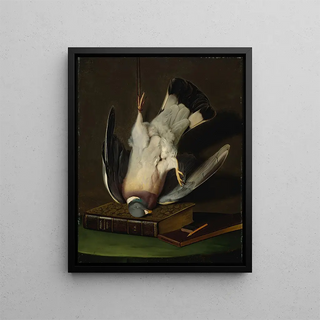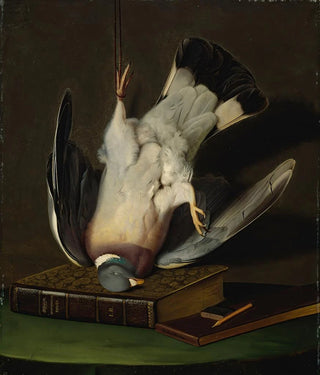Painting A dead wood pigeon - Ferdinand von Wright | Art print Source: Tableau Un pigeon ramier mort - Ferdinand von Wright | Reproduction


View from behind

Frame (optional)
Ferdinand von Wright's "Dead Stock Dove" is a masterpiece that transcends the simple realm of animal depiction. This painting, imbued with realism and emotion, immerses us in the fascinating universe of nature while questioning our relationship with life and death. By capturing the fleeting moment of a stock dove, the artist succeeds in awakening a reflection on the ephemeral beauty of existence. Through this artwork, the artist invites us to contemplate the fragility of life while celebrating the magnificence of wildlife. The art print of this masterpiece allows us to rediscover the intensity of this encounter between man and nature.
Style and uniqueness of the work
Ferdinand von Wright's style is distinguished by striking realism, which brings his subjects to life with remarkable precision. In "Dead Stock Dove," every feather, every anatomical detail is rendered with meticulous care that reflects the artist's attentive observation. The color palette, subtle and nuanced, enhances the depth of the piece, creating a contrast between the softness of natural tones and the harshness of mortality. This painting is not merely a simple representation; it evokes a melancholic, almost poetic atmosphere that touches us deeply. The composition, centered on the pigeon, draws the eye and invites introspective contemplation, making this work a true mirror of our emotions.
The artist and his influence
Ferdinand von Wright, an emblematic figure of the 19th century, established himself as a master of animal painting. His artistic journey, marked by a passion for nature and meticulous observation, allowed him to develop a unique style that combines realism and sensitivity. Influenced by the naturalist movements of his time, he transcended conventions to offer a personal and emotive vision of his subjects. His work, although often rooted in the animal world, resonates with universal themes such as life, death, and beauty. The impact of his work is still felt today, inspiring many contemporary artists to explore the links between man and nature through the lens of

Matte finish

View from behind

Frame (optional)
Ferdinand von Wright's "Dead Stock Dove" is a masterpiece that transcends the simple realm of animal depiction. This painting, imbued with realism and emotion, immerses us in the fascinating universe of nature while questioning our relationship with life and death. By capturing the fleeting moment of a stock dove, the artist succeeds in awakening a reflection on the ephemeral beauty of existence. Through this artwork, the artist invites us to contemplate the fragility of life while celebrating the magnificence of wildlife. The art print of this masterpiece allows us to rediscover the intensity of this encounter between man and nature.
Style and uniqueness of the work
Ferdinand von Wright's style is distinguished by striking realism, which brings his subjects to life with remarkable precision. In "Dead Stock Dove," every feather, every anatomical detail is rendered with meticulous care that reflects the artist's attentive observation. The color palette, subtle and nuanced, enhances the depth of the piece, creating a contrast between the softness of natural tones and the harshness of mortality. This painting is not merely a simple representation; it evokes a melancholic, almost poetic atmosphere that touches us deeply. The composition, centered on the pigeon, draws the eye and invites introspective contemplation, making this work a true mirror of our emotions.
The artist and his influence
Ferdinand von Wright, an emblematic figure of the 19th century, established himself as a master of animal painting. His artistic journey, marked by a passion for nature and meticulous observation, allowed him to develop a unique style that combines realism and sensitivity. Influenced by the naturalist movements of his time, he transcended conventions to offer a personal and emotive vision of his subjects. His work, although often rooted in the animal world, resonates with universal themes such as life, death, and beauty. The impact of his work is still felt today, inspiring many contemporary artists to explore the links between man and nature through the lens of
12,34 €






